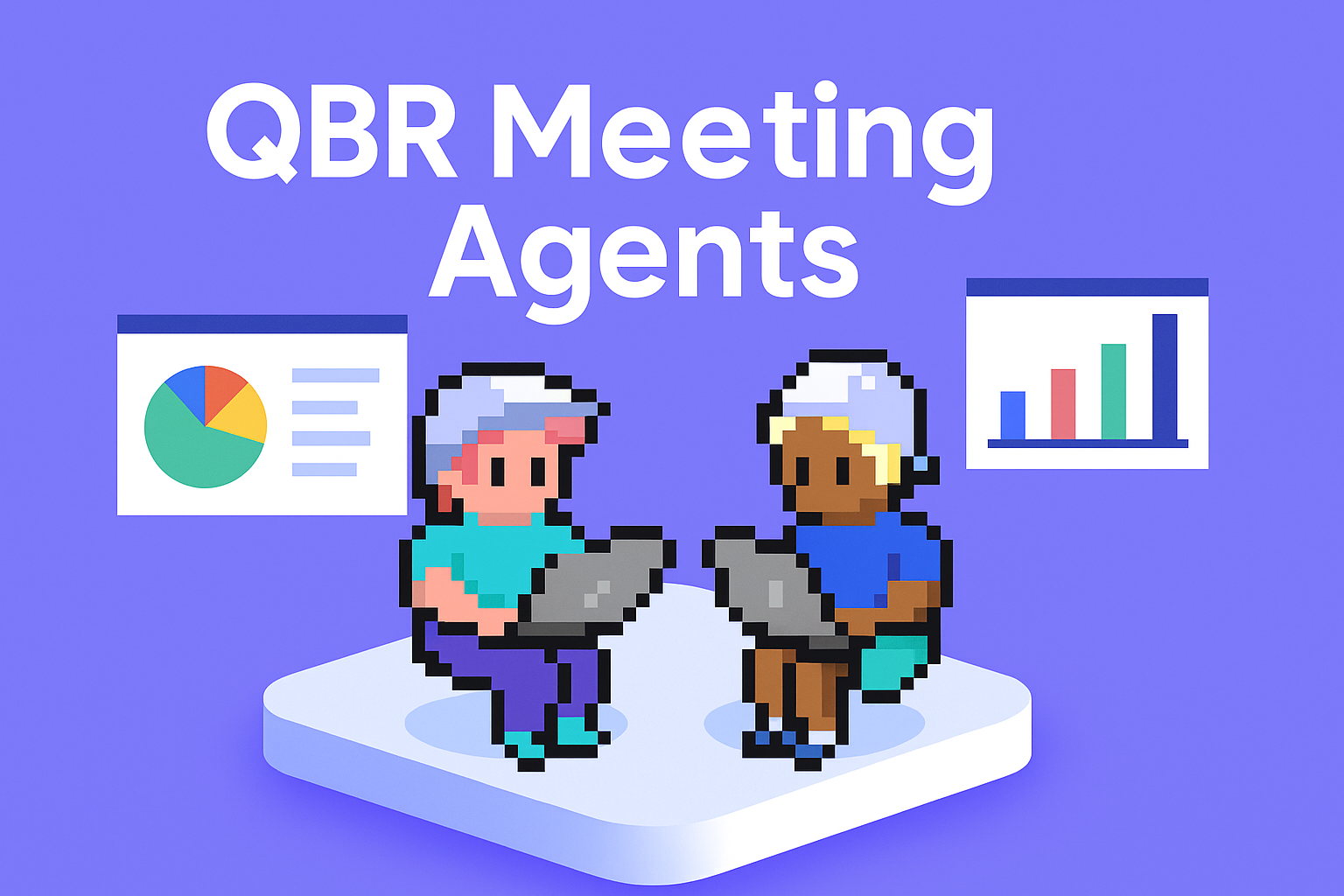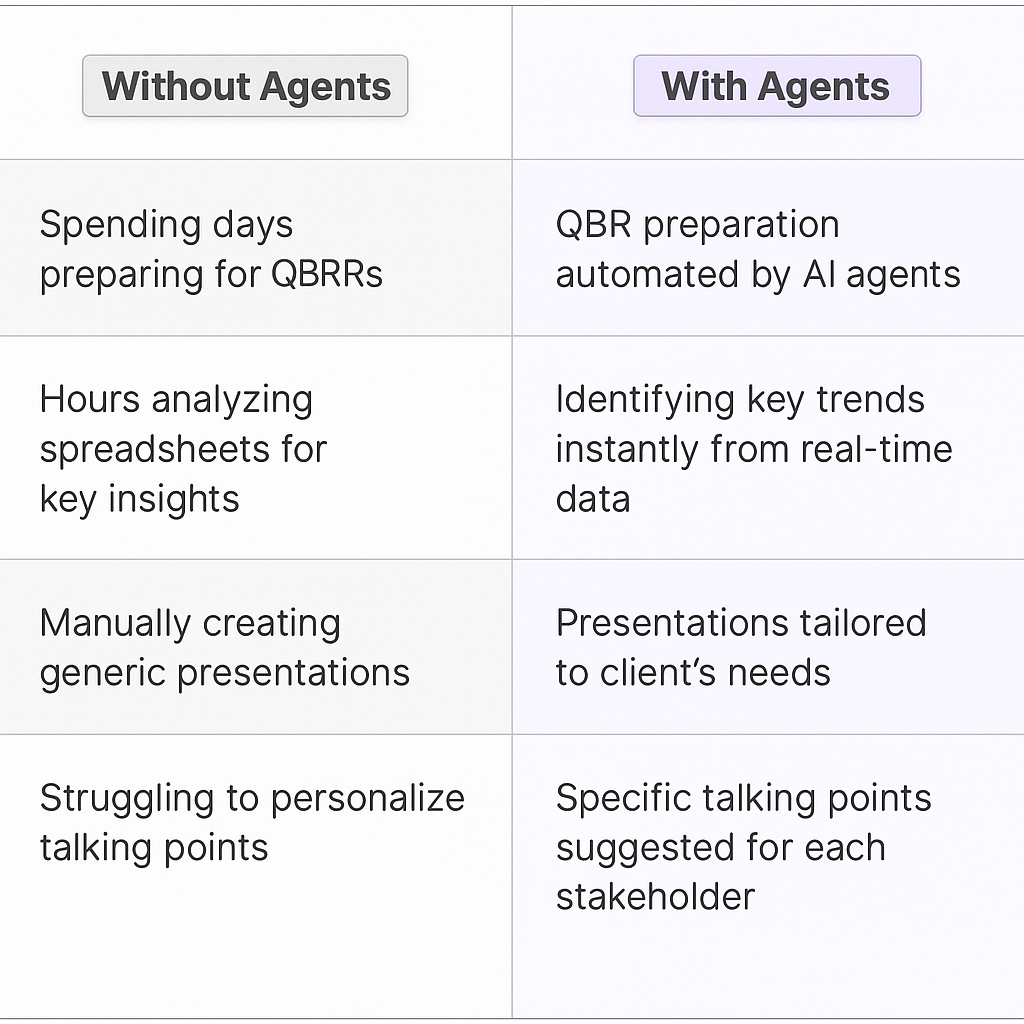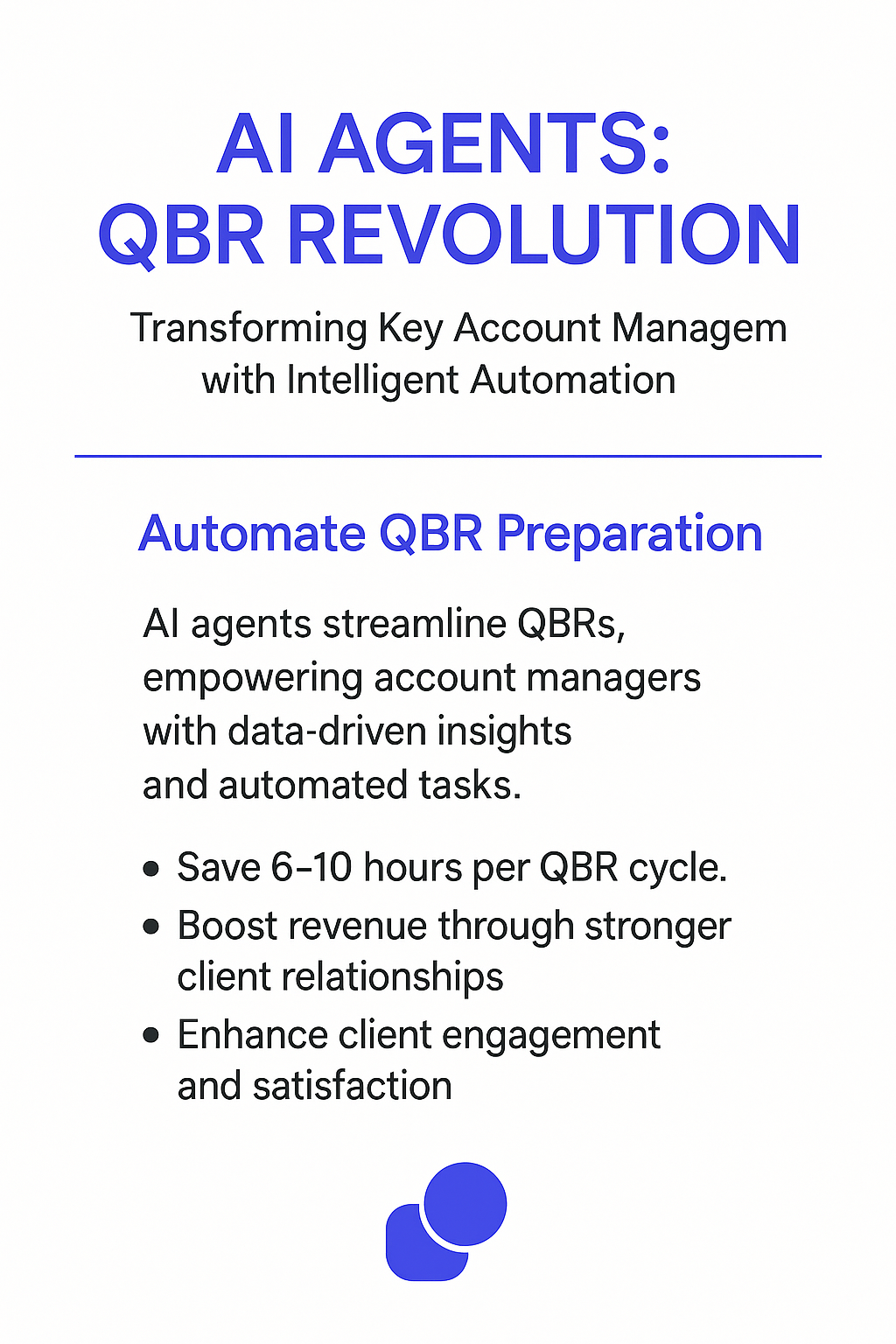
AI-powered QBR meeting agents are transforming how Key Account Managers prepare for and conduct Quarterly Business Reviews. These agents automate data analysis, presentation creation, and follow-up tasks, allowing managers to focus on building relationships and driving strategic conversations. This technology streamlines workflows, enhances client engagement, and improves overall account performance.
Before Meeting
Your AI agent analyzes account performance data, identifies key trends and insights, and generates a draft QBR presentation tailored to the client's specific needs and objectives. You walk into the meeting with a data-backed narrative ready to present.
During Meeting
As you present the QBR, your AI agent provides real-time support by surfacing relevant data points, answering client questions, and suggesting strategic initiatives based on the ongoing discussion. This ensures you're always prepared to address client concerns and capitalize on opportunities.
After Meeting
Post-meeting, your AI agent automatically generates a summary of key discussion points, action items, and agreed-upon next steps. It also updates your CRM and project management tools, ensuring seamless follow-up and accountability.
What you’ll need
You don't need to be a developer to set up this integration. Follow this simple guide to get started:
- Meeting Notetaker Agent template
- Calendar account
- Meetings to join
- Relevance AI Account

Who this agent is for
This agent is designed for Key Account Managers, Customer Success Managers, Sales Directors, and anyone responsible for conducting Quarterly Business Reviews (QBRs) with strategic clients. It's ideal for individuals and teams who need to synthesize large amounts of account data, usage metrics, and business outcomes into compelling presentations that demonstrate value and drive strategic conversations. Whether you're managing a portfolio of enterprise accounts or focusing on a few key strategic partnerships, this agent simplifies QBR preparation and ensures you're always prepared to deliver a high-impact presentation.
How this agent makes QBR planning easier
Automate data analysis and insight generation
Instead of manually compiling data from multiple sources, the agent automatically analyzes account performance across various dimensions, identifying key trends, insights, and opportunities.
Generate executive-ready presentations
The agent automatically generates visually appealing and data-rich QBR presentations, saving you hours of manual design and formatting.
Personalize talking points for different stakeholders
The agent identifies key stakeholder personas within the client organization and suggests specific talking points that will resonate with each individual.
Streamline follow-up and action item tracking
The agent automatically generates a summary of key discussion points, action items, and agreed-upon next steps, ensuring seamless follow-up and accountability.
Benefits of AI Agents for Key Account Managers
What would have been used before AI Agents?
Key Account Managers traditionally relied on manual data collection, spreadsheet analysis, and PowerPoint presentations to prepare for QBRs. This process was time-consuming, prone to errors, and often resulted in generic presentations that failed to resonate with clients. They would spend valuable time gathering data, creating charts, and crafting narratives, taking away from their core responsibilities of building relationships and driving strategic conversations.
What are the benefits of AI Agents?
AI agents offer a streamlined and automated approach to QBR preparation, freeing up Key Account Managers to focus on more strategic tasks. The most significant benefit is the time saved by automating data analysis and presentation creation. The agent handles everything from identifying key trends to generating visually appealing slides, reducing the administrative burden on the manager.
AI agents also improve the quality and relevance of QBR presentations by providing data-driven insights and personalized talking points. This ensures that the presentation resonates with clients and drives meaningful conversations. Furthermore, the agent enhances follow-up and accountability by automatically generating summaries and tracking action items.
By integrating with existing CRM and project management tools, the agent provides a seamless and user-friendly experience. This eliminates the need for manual data entry and ensures that all QBR-related information is accurately recorded and easily accessible. Ultimately, AI agents enhance productivity, improve client engagement, and allow Key Account Managers to focus on building strong relationships and driving revenue growth.
Traditional vs Agentic meeting planning
Traditionally, Key Account Managers spent days preparing for QBRs, manually compiling data and creating presentations. Now, AI agents automate this, freeing up time for strategic thinking. Before, identifying key insights required hours of spreadsheet analysis. With an agent, key trends are surfaced instantly, based on real-time data. Presentation creation used to be a manual task, often resulting in generic slides. Now, presentations are automatically generated and tailored to the client's specific needs. Personalizing talking points for different stakeholders was a challenge. The agent suggests specific talking points that resonate with each individual. Finally, manual follow-up was prone to errors. The agent syncs seamlessly, keeping everything accurate and up-to-date.

Tasks that can be completed by a QBR Agent
Key Account Managers juggle numerous tasks, from managing client relationships to developing account strategies and driving revenue growth. A QBR agent can handle many of the administrative tasks associated with preparing for and conducting QBRs, allowing managers to focus on their core responsibilities.
Analyzing Account Performance Data
The agent analyzes account performance data from various sources, identifying key trends, insights, and opportunities.
Generating QBR Presentations
The agent automatically generates visually appealing and data-rich QBR presentations, saving you hours of manual design and formatting.
Personalizing Talking Points
The agent identifies key stakeholder personas within the client organization and suggests specific talking points that will resonate with each individual.
Creating Meeting Agendas
The agent can create and distribute meeting agendas, ensuring that all participants are aware of the topics to be discussed.
Recording Meeting Minutes and Action Items
The agent can record meeting minutes, track action items, and send follow-up emails to ensure that everyone is aware of their responsibilities.
Integrating with CRM and Project Management Tools
The agent can integrate with CRM and project management tools, automatically updating account records and creating follow-up tasks.
Handling Time Zone Conversions
The agent automatically converts meeting times to each participant's local time zone, eliminating confusion and ensuring everyone attends at the correct hour.
Managing Recurring Meetings
The agent can schedule and manage recurring meetings, ensuring that they are automatically added to everyone's calendar and that reminders are sent regularly.

Things to Keep in Mind When Building a QBR Agent
Building an effective QBR agent requires careful planning and attention to detail. The goal is to create an agent that seamlessly integrates with your existing workflows and provides a user-friendly experience for all participants.
Define Clear Objectives
Before you start building your agent, define clear objectives for what you want it to achieve. Do you want to reduce QBR preparation time, improve presentation quality, enhance client engagement, or all of the above? Having clear objectives will help you prioritize features and measure success.
Integrate with Existing Data Sources
Ensure that your agent integrates seamlessly with your existing data sources, such as CRM systems, analytics platforms, and billing systems. This will allow the agent to access the data it needs to generate insights and create presentations.
Prioritize User Experience
Make sure that the agent is easy to use and intuitive. The interface should be clean and uncluttered, and the QBR preparation process should be straightforward and efficient.
Automate Reminders and Follow-Ups
Configure the agent to send automated reminders and follow-up emails to keep participants informed and engaged. This will help reduce no-shows and ensure that everyone is aware of their responsibilities.
Handle Time Zone Conversions Accurately
Ensure that the agent accurately converts meeting times to each participant's local time zone. This is especially important for teams that are distributed across different geographic locations.
Provide Customizable Settings
Allow users to customize the agent's settings to match their preferences. This might include setting preferred presentation templates, specifying data sources, and choosing which CRM and project management tools to integrate with.
Test Thoroughly
Before you roll out the agent to your entire team, test it thoroughly to ensure that it is working correctly and that it meets your objectives. Gather feedback from users and make any necessary adjustments.
Continuously Improve
Once your agent is live, continue to monitor its performance and gather feedback from users. Use this information to identify areas for improvement and make ongoing enhancements.
The Future of AI Agents in QBR Planning
The future of AI agents in QBR planning is bright, with advancements in natural language processing, machine learning, and artificial intelligence promising to further streamline and enhance the QBR process. Future agents will be able to understand complex client needs, anticipate potential challenges, and proactively suggest solutions.
AI agents will also become more personalized, learning individual client preferences and tailoring their recommendations accordingly. They will be able to identify preferred communication styles, presentation formats, and even preferred topics of discussion, creating a more seamless and engaging experience.
Furthermore, AI agents will play a larger role in facilitating collaboration and communication during QBRs. They will be able to transcribe meeting minutes, track action items, and even provide real-time translation services, making QBRs more productive and inclusive.
AI agents will also integrate with other business applications, such as sales forecasting tools and customer health dashboards, providing a holistic view of account performance and enabling better decision-making.
Ultimately, the future of AI agents in QBR planning is about creating intelligent systems that not only automate the QBR process but also enhance client engagement, improve communication, and drive better business outcomes.









